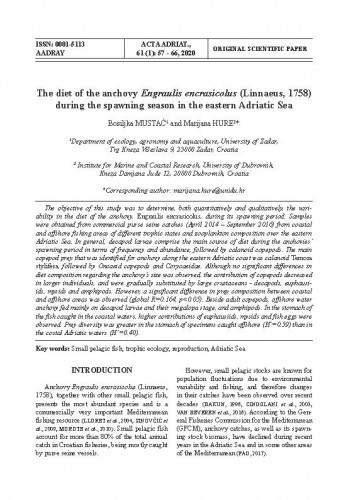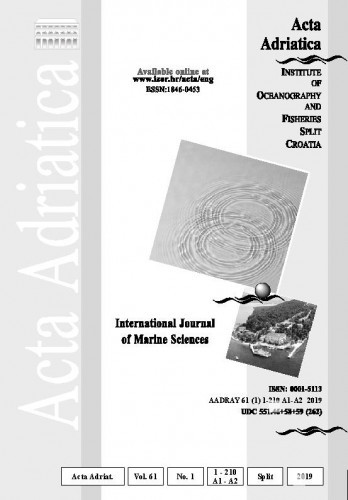The objective of this study was to determine, both quantitatively and qualitatively, the variability in the diet of the anchovy, Engraulis encrasicolus,during its spawning period. Samples were obtained from commercial purse seine catches (April 2014 – September 2016) from coastal and offshore fishing areas of different trophic states and zooplankton composition over the eastern Adriatic Sea. In general, decapod larvae comprise the main source of diet during the anchovies’ spawning period in terms of frequency and abundance, followed by calanoid copepods. The main copepod prey that was identified for anchovy along the eastern Adriatic coast was calanoid Temora stylifera, followed by Oncaeid copepods and Corycaeidae. Although no significant differences in diet composition regarding the anchovy’s size was observed, the contribution of copepods decreased in larger individuals, and were gradually substituted by large crustaceans - decapods, euphausiids, mysids and amphipods. However, a significant difference in prey composition between coastal and offshore areas was observed (global R=0.164, p<0.05). Beside adult copepods, offshore water anchovy fed mainly on decapod larvae and their megalopa stage, and amphipods. In the stomach of the fish caught in the coastal waters, higher contributions of euphausiids, mysids and fish eggs were observed. Prey diversity was greater in the stomach of specimens caught offshore (H’=0.59) than in the coastal Adriatic waters (H’=0.40).; Cilj ovog rada bio je utvrditi kvantitativnu i kvalitativnu varijabilnost u prehrani brgljuna Engraulis encrasicolus tijekom mrijesta. Uzorci iz komercijalnih ulova plivaricom (travanj 2014. – rujan 2016.), obuhvatili su ribolovna područja obalnog i otvorenog mora duž istočne obale Jadrana, različitog trofičkog stanja i sastava zooplanktona. Ličinke deseteronožaca općenito su glavni izvor hrane tijekom mrijesta brgljuna, a prate ih kalanoidni veslonošci. Unutar veslonožaca najzastupljenija je bila vrsta kalanoida Temora stylifera, a slijede veslonošci skupine Oncaea i porodica Corycaeidae. Premda nisu utvrđene značajne razlike u sastavu prehrane u odnosu na dužinu ribe, udio veslonožaca smanjio se porastom dužine brgljuna, a postupno su ih nadomještali veliki rakovi - deseteronošci, eufazidi, rašljonožci i rakušci. Međutim, uočena je značajna razlika u sastavu plijena između obalnog i otvorenog mora (globalni R = 0.164, p <0.05). Pored odraslih veslonožaca, brgljun otvorenog mora hranio se uglavnom ličinkama deseteronožaca i njihovih megalopa stadija te rakušci. U želucu ribe ulovljene u obalnim vodama primijećen je veći doprinos eufauzida, rakušcima i ribljih jaja. Raznolikost plijena bila je veća u želucima jedinki ulovljenih u otvorenim vodama (H’=0.59) nego u obalnom dijelu Jadrana (H’=0.40).
Sažetak

 Acta Adriatica : 61,1(2020) / glavni urednik Jakov Dulčić.
Acta Adriatica : 61,1(2020) / glavni urednik Jakov Dulčić.